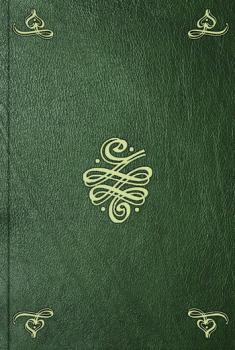ТОП просматриваемых книг сайта:
Samuel Hahnemann
Список книг автора Samuel HahnemannАннотация
Organon of Medicine, originally Organon of the Art of Healing, is a book by Samuel Hahnemann in which he laid out the doctrine of his ideas of homoeopathy. The book is considered the most important work in the field. Hahnemann wrote this book in order to document his new system of medicine. After conducting personal observations and experiments, Hahnemann published his new account of homoeopathy in book form. The book begins with a preface by the author on the subject, with a vast introduction to the subject, the philosophy and the presentation of how Homoeopathy became a method of practice in the medical profession. Organon of Medicine is split into «Aphorisms», numbered 1 to 294. The doctrine of Homoeopathy is discussed in the first seventy aphorisms, often referred to as the theoretical part, while aphorisms 71–294 are known as the practical part: Theoretical part: The mission of Physician and Highest Ideal of cure: Aphorisms 1–2 Requisite knowledge of a physician: 3–4 Knowledge of disease: 5–18 Knowledge of drugs: 19–21 Application of drug knowledge to disease: 22–27 Knowledge of choice of remedy, different modes of treatment, superiority of homoeopathic therapeutics: 28–70 Practical part: Three points, which are necessary for curing: 71 Classification of disease: 72–80 Case Taking: recording of patient data. 83–104 Knowledge of medicinal power, curative power and drug proving: 105–145 Proving of drugs Most suitable method of employing medicine to a patient: 146–261 Allied support during treatment, diet in acute diseases: 262–263 Preparation of medicines: 267–269 Administration of medicines: 271–292 Mesmerism: 293–294
Аннотация
Homeopathy or homoeopathy is a pseudoscientific system of alternative medicine. It was created by Samuel Hahnemann. Its practitioners, called homeopaths, believe that a substance that causes symptoms of a disease in healthy people would cure similar symptoms in sick people; this doctrine is called «similia similibus curentur,» or «like cures like». The term «homeopathy» was coined by Hahnemann which comes from the Greek: hómoios, «like» and páthos, «suffering». Hahnemann gathered and published a complete overview of his new medical system in his book, The Organon of the Healing Art, whose 6th edition, known as Organon of Medicine, is still relevant today. Homeopathic healing is considered controversial and it received a lot of critique over the years, but it still survived and is practiced today. Table of Contents: Organon of Medicine by Samuel Hahnemann Of the Homoeopathic Doctrines by J. G. Millingen Homoeopathy as a Science by Edward Bayard Personal Experience of a Physician by John Ellis
Аннотация
Organon of Medicine, originally Organon of the Art of Healing, is a book by Samuel Hahnemann in which he laid out the doctrine of his ideas of homoeopathy. The book is considered the most important work in the field. Hahnemann wrote this book in order to document his new system of medicine. After conducting personal observations and experiments, Hahnemann published his new account of homoeopathy in book form. The book begins with a preface by the author on the subject, with a vast introduction to the subject, the philosophy and the presentation of how Homoeopathy became a method of practice in the medical profession. Organon of Medicine is split into «Aphorisms», numbered 1 to 294. The doctrine of Homoeopathy is discussed in the first seventy aphorisms, often referred to as the theoretical part, while aphorisms 71–294 are known as the practical part: Theoretical part: The mission of Physician and Highest Ideal of cure: Aphorisms 1–2 Requisite knowledge of a physician: 3–4 Knowledge of disease: 5–18 Knowledge of drugs: 19–21 Application of drug knowledge to disease: 22–27 Knowledge of choice of remedy, different modes of treatment, superiority of homoeopathic therapeutics: 28–70 Practical part: Three points, which are necessary for curing: 71 Classification of disease: 72–80 Case Taking: recording of patient data. 83–104 Knowledge of medicinal power, curative power and drug proving: 105–145 Proving of drugs Most suitable method of employing medicine to a patient: 146–261 Allied support during treatment, diet in acute diseases: 262–263 Preparation of medicines: 267–269 Administration of medicines: 271–292 Mesmerism: 293–294
Аннотация
Homeopathy or homoeopathy is a pseudoscientific system of alternative medicine. It was created by Samuel Hahnemann. Its practitioners, called homeopaths, believe that a substance that causes symptoms of a disease in healthy people would cure similar symptoms in sick people; this doctrine is called «similia similibus curentur,» or «like cures like». The term «homeopathy» was coined by Hahnemann which comes from the Greek: hómoios, «like» and páthos, «suffering». Hahnemann gathered and published a complete overview of his new medical system in his book, The Organon of the Healing Art, whose 6th edition, known as Organon of Medicine, is still relevant today. Homeopathic healing is considered controversial and it received a lot of critique over the years, but it still survived and is practiced today. Table of Contents: Organon of Medicine by Samuel Hahnemann Of the Homoeopathic Doctrines by J. G. Millingen Homoeopathy as a Science by Edward Bayard Personal Experience of a Physician by John Ellis
Die chronischen Krankheiten, ihre eigenthumliche Natur und homoopathische Heilung. T. 1 - Samuel Hahnemann
Аннотация
Полный вариант заголовка: «Die chronischen Krankheiten, ihre eigenthumliche Natur und homoopathische Heilung. 1 Theil / von Samuel Hahnemann».






